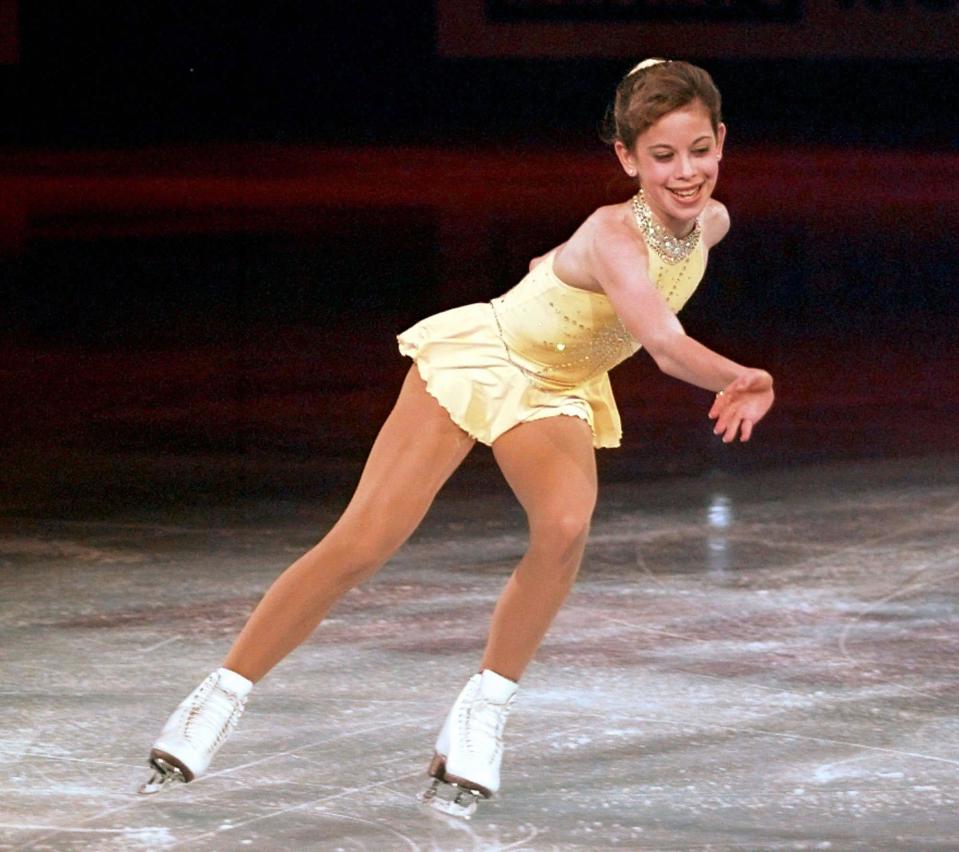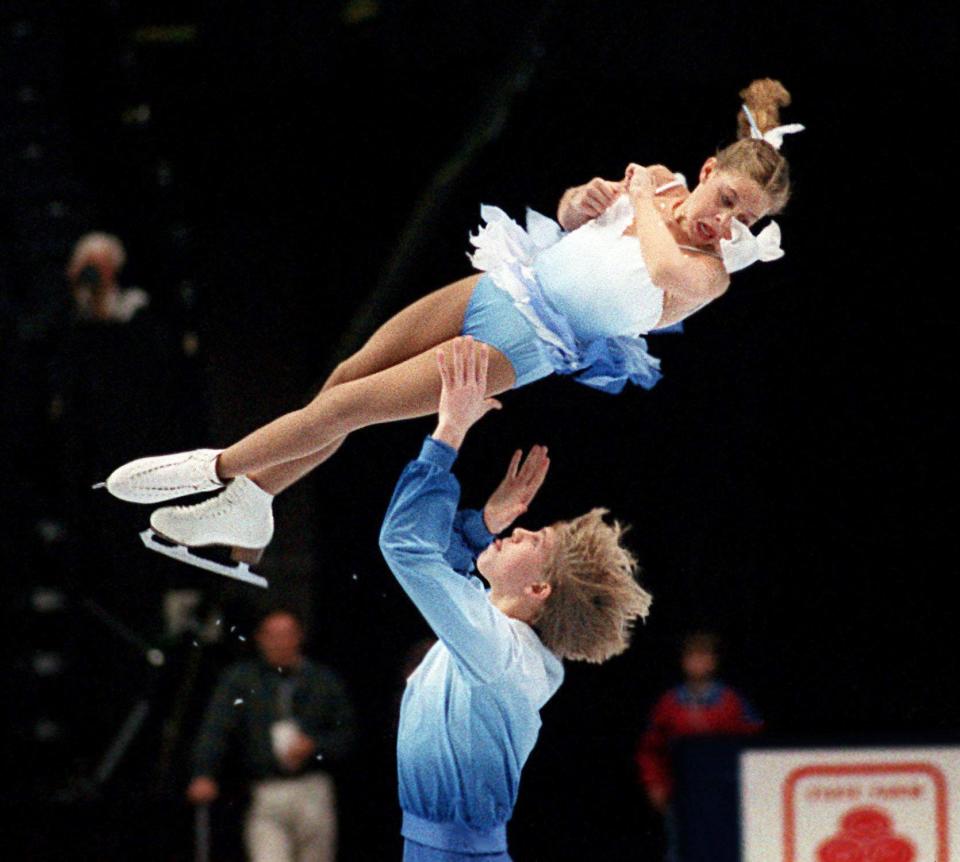How is figure skating scored at 2022 U.S. Championships? A complete guide

Figure skaters going for the gold need to skate a perfect performance, and do a little math along the way. The skater or team with the highest point total will win the competition in men’s, women’s, pairs and ice dance at the U.S. Figure Skating Championships at Bridgestone Arena this week, and we’ve got your guide to understanding how all the numbers add up.
First, the basics:
Technical Element Score (TES) + Program Component Score (PCS) = Total Segment Score (one for the short program and one for the long program)
Short Program Segment Score + Long Program Segment Score = Total Score
Technical Element Score (TES)
The TES is the total number of points each skater or team earns by completing jumps, spins and other required elements. The high and low scores are thrown out, and then the average of the remaining judges’ scores makes up the TES.
Every jump, spin, footwork sequence or lift performed in a skating program is assigned a base value.
Skaters earn or lose points off the base value of an element based on how well it is performed. The scale, which is the grade of execution (GOE), goes from -5 to 5. A fall guarantees a -5, and a perfectly executed jump can earn positive points.
Degree of difficulty for figure skating elements ranges from Basic to Levels 1-4. Jumps do not earn levels, as their difficulty is reflected in the base value.
Figure skating lingo: All the figure skating terms you'll need for U.S. Figure Skating Championships 2022
Nashville flair: Madison Chock and Evan Bates bringing love — and maybe cowboy hats — to 2022 U.S. Figure Skating Championships
Spins, footwork and lifts do earn levels. Spins can earn Level 4 based on number of revolutions and difficulty of positions; lifts can earn Level 4 based on creative or difficult entrances and exits.
If a skater gets a Basic Level in their score, you can bet something went wrong. Skaters at this elite level are aiming for Level 4 on all of their required level elements.

Program Component Score (PCS)
PCS can be summed up as the “artistic” portion of the score, but it actually involves five categories:
Skating Skills (how the skater moves across the ice and the quality of their edges and turns; there shouldn’t be noisy scratches from toe picks.)
Transitions (how difficult are the steps used to connect the required elements in a program?)
Performance
Composition (how the required elements are arranged within the program, including how skaters utilize the full ice surface.)
Interpretation of the music
PCS scores can range from 0.25 to 10 (legendary champion Michelle Kwan on her best day would be a 10).
High and low scores are tossed out here as well, then each of the five categories are averaged and added together. This total is multiplied by a set factor to ensure the technical and performance aspects of the program are balanced.
Who gives out these scores?
The technical specialist leads the team on the judging panel that identifies each element as it is performed and assigns a level of difficulty to level elements.
The nine judges assign a grade of execution to each element determined by the technical specialist and also input the PCS marks.
How Skaters Earn Extra Points
Skaters earn bonus points for required elements in the second half of their program, since it is more difficult to complete those elements when fatigued. An element’s base value is multiplied by 1.1 if it occurs in the second half.
More difficult elements have a higher base value, and the grade of execution is factored to be worth more. So a +5 GOE on a single axel is not worth as much as a +5 on a triple axel.
How Skaters Lose Points
A fall guarantees a one-point deduction, in addition to points lost off the base value.
Underrotations, when part of a jump’s revolutions occur after a skater’s foot lands on the ice, can penalize skaters in two ways:
If the jump is a quarter turn or less underrotated, it keeps the base value and will just lose points on GOE.
If it is more than a quarter turn underrotated, the jump will be downgraded. So an underrotated triple (three-revolution) jump would only earn the base value of a double (two-revolution) jump in that case.
Skaters who utilize incorrect edges on jumps, which are identified by the edge and direction of their takeoff, are also penalized. For instance, the flip and lutz jumps take off on different edges of the blade: inside for flip and outside for lutz. If either of these jumps takes off of an incorrect edge, the skater's scoresheet is noted in one of two ways:
An "!" next to the jump on the scoresheet is basically like a warning sign. The technical specialist noticed the takeoff was questionable but allowed the jump to keep the same base value. Points may still be lost on grade of execution, however.
An "e" on the scoresheet next to the jump indicates the takeoff was incorrect and results in a lower base value.
Judges have access to instant replay video to assess jumps for underrotation and edge errors after the program is complete.
In ice dance, lifts must be executed in a designated amount of seconds, and if the lift lasts too long, the team will lose points.
Skaters’ programs must be the assigned length — 2 minutes, 50 seconds for the short program and 4 minutes for the long program, plus or minus 10 seconds — or else get a time violation.
Since this is figure skating and sparkling costumes take the place of team uniforms, there is always the potential for a costume violation deduction. Costumes must be designed within a certain set of rules and must be athletic in nature and not overly theatrical.
What number is a good score?
Men’s Event: Over 300 points
In 2021, Nathan Chen won his fifth straight U.S. title with 322.28 points. He and last year’s silver medalist Vincent Zhou will look to top 300 points, aiming for 100 in the short and 200 in the long. Other men’s contenders will likely score in the high 200s for total score.
Women’s Event: 215-230 points
Last year’s women’s champ Bradie Tennell won with 232.61 points. Skaters will be looking for a score in the high-70s in the short and mid-100s in the long.
Pairs Event: 215-230 points
Defending champions Alexa Knierim and Brandon Frazier won the gold with 228.1 last year. Similar to the women’s event, the teams will be aiming for high-70s in the short and mid-100s in the long.
Ice Dance Event: 215-230 points
Champions in 2018, 2019 and 2021, Madison Hubbell and Zachary Donohue took the gold last year with 224.56 points. The top teams will score mid-80s to 90s in the rhythm dance and aim for 120-to-130 points in the free dance.
These scores are a bit higher than what you will see once the skaters head to the Olympics in February, because of what often is a nationals scoring bump. Think of it like home field advantage in another sport; the home country judges are more generous with the scores.
This article originally appeared on Nashville Tennessean: A guide to how figure skating is scored at U.S. Championships

